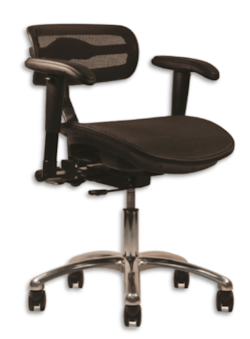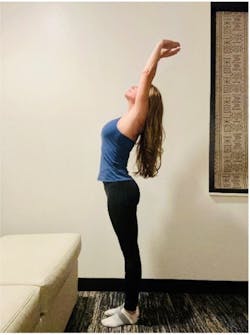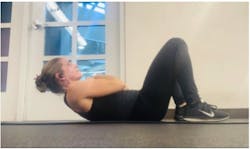Wellness Corner: Chained to the desk—4 ergonomic solutions for the dental business team
Despite the sophisticated business attire, the dental front office is not a glamorous job. The unyielding demand for attention starts with the first greetings and goes to nonstop phone calls, insurance claim/coverage battles, and treatment plan presentations that flow into the lunch break and well past the end of operating hours. Yes, this author may be a hygienist and ergonomics expert now, but the four-plus years working the front desk of dental offices left quite an unforgettable mark—not the least of which was an ergonomic struggle all its own.
What seems like a physically “simple” job of sitting at a desk answering a phone offers occupants slash captives a ton of associated body pain. Studies show that 40%–70% of office workers who sit at a desk for three to five hours per day experience pain, and that pain is dose-related. The longer we sit at a desk, the worse the pain and damage gets. The location of the body pain is slightly different in order of prevalence for front-office staff versus back-office staff, with low back being number one at 72.4%.1 In addition to back pain, 58% of desk workers report arm, neck, and shoulder pain.2
The question is why. The answer is static, unneutral posture for long periods of time. Said differently, sitting in a chair for hours is terrible for the body!
Solution no. 1: Movement
Sit/stand desks offer workers the ability to vary posture, to sit or to stand. Standing leads to microshifting of body weight from one foot to another in a neutral position.
The spine has a natural curvature that includes an inward lumbar curve for even intervertebral disc spacing and pressure. When the pelvis rolls under to place the bum on a seat pan, the lumbar curvature flattens out, causing nerves to pinch, discs to bulge, and the hip flexor muscle to shorten and become tight after prolonged periods of time. All this eventually causes low back pain.
Having the option to sit or stand can create movement in a position that often keeps the staff member chained to one stationary position for as far as the telephone cord will allow.
Solution no. 2: Ergonomic equipment
A chair that is fully adjustable, a headset instead of a handheld phone, a wrist rest to place the wrist in neutral and reduce contact stress from the sharp 90° corner of a desk, a footrest for proper leg positioning, and an ergonomic mouse or keyboard are all highly effective pieces of ergonomic equipment for the business team. They all can help workers avoid injury from contact stress/pressure or awkward positioning—two of the top five workplace risk factors according to OSHA.3
Look for a chair that is height adjustable with lumbar support to prevent a flat lumbar curvature, armrests that place the arms resting at the elbow directly next to the torso (not out and away from the trunk), and a seat pan that tapers downward at the back of the thigh to encourage blood circulation through the thighs and down the legs.
We’ve all seen the position where the person on the phone has their shoulder hiked up and head tilted over to the side to hold the phone so they can mouse or type. Talk about an ergonomic nightmare! A headset removes these risks in one tiny piece of equipment—especially if it’s a cordless headset that allows the user to move about the office.
Solution no. 3: Stretching
A team that stretches together, stays together. Since we know that sitting for long periods of time can lead to tight, stiff muscles, incorporating stretching into the office culture can be a great way to prevent injury. Studies show a significant reduction in long-term pain reported with the use of regular stretching.4
The morning huddle is a great place to begin. To start, practice reaching above the head as high as possible while pushing the hips forward. Next, hinge forward, aiming the hands toward the floor (but don’t touch the floor). Resting the hands at the feet or on the ankles is adequate as long as the spine isn’t rounded. Next, stand and bring the elbows up so the biceps are parallel to the floor and push the elbows back. Last, twist the trunk, looking as far over one shoulder as possible at a time.
Solution no. 4: Exercise
Strength training helps build muscle that combats poor posture habits. Studies show that we can use strength training to significantly reduce body pain for office workers.5 Strength training uses resistance—weight—to push, pull, and move around the body to build muscle. This can be done with body weight, resistance bands, cable machines, or free weights.
To strengthen the back, do movements that pull weight toward the body. Use movements that push weight away from the body to strengthen the front of the body, such as the chest or shoulders. For the core, abdominal contractions that bring the upper body off the floor is enough resistance to provide muscle development.
Editor’s note: This article first appeared in Clinical Insights newsletter, a publication of the Endeavor Business Media Dental Group. Read more articles and subscribe.
References
- Mohammadipour F, Pourranjbar M, Naderi S, Rafie F. Work-related musculoskeletal disorders in Iranian office workers: prevalence and risk factors. J Med Life. 2018;11(4):328-333. doi:10.25122/jml-2018-0054
- Iram H, Kashif M, Sattar M, Bhatti ZM, Dustgir A, Mehdi Z. Ergonomic risk factors among computer office workers for complaints of arm, neck and shoulder and workstation evaluation. Work. 2022;73(1):321-326. doi:10.3233/WOR-211029
- Identify Problems. Occupational Safety and Health Administration. https://www.osha.gov/ergonomics/identify-problems
- Shariat A, Cleland JA, Danaee M, Kargarfard M, Sangelaji B, Tamrin SBM. Effects of stretching exercise training and ergonomic modifications on musculoskeletal discomforts of office workers: a randomized controlled trial. Braz J Phys Ther. 2018;22(2):144-153. doi:10.1016/j.bjpt.2017.09.003.
- Holzgreve F, Fraeulin L, Maurer-Grubinger C, et al. Effects of resistance training as a behavioural preventive measure on musculoskeletal complaints, maximum strength and ergonomic risk in dentists and dental assistants. Sensors (Basel). 2022;22(20):8069. doi:10.3390/s22208069
About the Author

Katrina Klein, RDH, CEAS, CPT
Katrina Klein, RDH, CEAS, CPT, is a 15-year registered dental hygienist, national speaker, author, competitive bodybuilder, certified personal trainer, certified ergonomic assessment specialist, and biomechanics nerd. She’s the founder of ErgoFitLife, where she teaches that ergonomics and fitness are a lifestyle to prevent, reduce, and even eliminate workplace pain.





